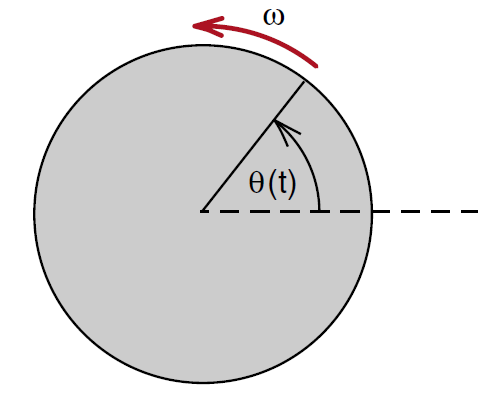


 الفيزياء الكلاسيكية
الفيزياء الكلاسيكية
 الكهربائية والمغناطيسية
الكهربائية والمغناطيسية
 علم البصريات
علم البصريات
 الفيزياء الحديثة
الفيزياء الحديثة
 النظرية النسبية
النظرية النسبية
 الفيزياء النووية
الفيزياء النووية
 فيزياء الحالة الصلبة
فيزياء الحالة الصلبة
 الليزر
الليزر
 علم الفلك
علم الفلك
 المجموعة الشمسية
المجموعة الشمسية
 الطاقة البديلة
الطاقة البديلة
 الفيزياء والعلوم الأخرى
الفيزياء والعلوم الأخرى
 مواضيع عامة في الفيزياء
مواضيع عامة في الفيزياء|
Read More
Date: 15-12-2016
Date: 29-11-2020
Date: 15-9-2020
|
Angular Velocity
The typical measure of angular velocity you may be familiar with is revolutions per minute (RPM). The tachometer in a sports car is calibrated in RPM; a typical sports car engine gives its maximum power around 5000 RPM. Engine manufacturers in Europe are beginning to change over to revolutions per second (RPS), but somehow revving an engine up to 83 RPS doesn't sound as impressive as 5000 RPM. (Tachometers will probably be calibrated in RPM for a while.)
In physics texts, angular velocity is measured in radians per second. Since there are 2π radians/cycle, 83 revolutions or cycles per second corresponds to 2π × 83 = 524 radians/second. Few people would know what you were talking about if you said that you should shift gears when the engine got up to 524 radians per second.
Our formal definition of angular velocity is the time rate of change of an angle. We almost always use the Greek letter ω (omega) to designate angular velocity
 ..........(1)
..........(1)
When thinking of angular velocity ω picture a line marked on the end of a rotating shaft. The angle θ is the angle that the line makes with the horizontal as shown in Figure (1). As the shaft rotates, the angle θ (t) increases with time, increasing by 2π every time the shaft goes all the way around.

Figure 1: End of a shaft rotating at an angular velocity ω .



|
|
|
|
4 أسباب تجعلك تضيف الزنجبيل إلى طعامك.. تعرف عليها
|
|
|
|
|
|
|
أكبر محطة للطاقة الكهرومائية في بريطانيا تستعد للانطلاق
|
|
|
|
|
|
|
العتبة العباسية المقدسة تبحث مع العتبة الحسينية المقدسة التنسيق المشترك لإقامة حفل تخرج طلبة الجامعات
|
|
|